You might not spend a lot of time thinking about it, but your RV roof always has you covered – literally!
Many RVers don’t feel the need to check their RV’s roof very often, as long as things seem to be working normally. We know RVers who actually never go up on their roof. But just like the roof on a traditional home, it’s crucial to understand this vital part of your RV so that you can care for it properly. A little bit of knowledge and maintenance will keep problems from popping up and help you prepare for when they do.
Let’s climb on up and take a look at your RV roof and some things you should know about it.
Types of RV Roofs
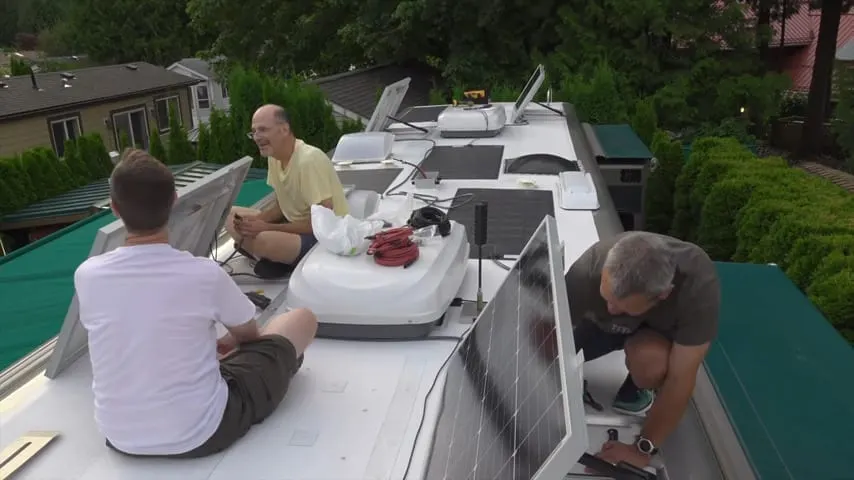
Knowing as much information as possible about your RV roof is wise – like whether it can withstand the weight of three people!
There are four main types of RV roofs, each of which has different strengths and drawbacks. We’ve broken them down for you and summarized the information about each type.
EPDM RV Roof
EPDM (Ethylene Propylene Diene Monomer) is a rubber membrane typically used on flat roofs. It’s one of the most frequently used RV roofing materials and is often made from recycled materials like tires, sawdust, and slate dust.
Pros
An EPDM roof is lightweight and easy to install, and repair. The material is resistant to scratches, scuffs, and dents. It can also resist leaks by having fewer seams since it’s manufactured in large, continuous rolls. It’s also an affordable roofing option and can easily last up to 25 years, or longer if properly maintained.
Cons
Although EPDM can resist significant damage, punctures are its kryptonite. It’s fairly easy to poke a hole in the material, which will require quick repairs to prevent water penetration.
The top surface of an EPDM roof is typically quite smooth, which can lead it to be slippery when wet. It’s also prone to leaving white or black streaks down the side of your RV… a result of the slight “shedding” that occurs as a protective mechanism against UV damage.
How to Care for an EPDM RV Roof
Keeping your EPDM roof clean is an integral part of ensuring a long life. Depending on how much you use your RV, you’ll want to clean it thoroughly a minimum of once a year. But if used regularly, you should ideally plan to wash and condition it at least once every 3-6 months.
Start by gently sweeping loose debris off the roof. Then wet the roof and wash it with a gentle, rubber-safe cleaner (avoid anything with petroleum distillates or citrus cleaners as they can damage the membrane). If you don’t want to use a dedicated product to clean your roof, a popular choice is to use the same type of car wash soap typically used to wash the entire RV. Be sure to use a soft-bristled brush or sponge to avoid damaging the membrane in any way.
You can extend the life of your EPDM roof significantly by using a protectant designed to preserve the material, keeping it pliable and protected from UV damage. Once the roof has been cleaned, follow the instructions for the protectant you’re using, and apply it accordingly.
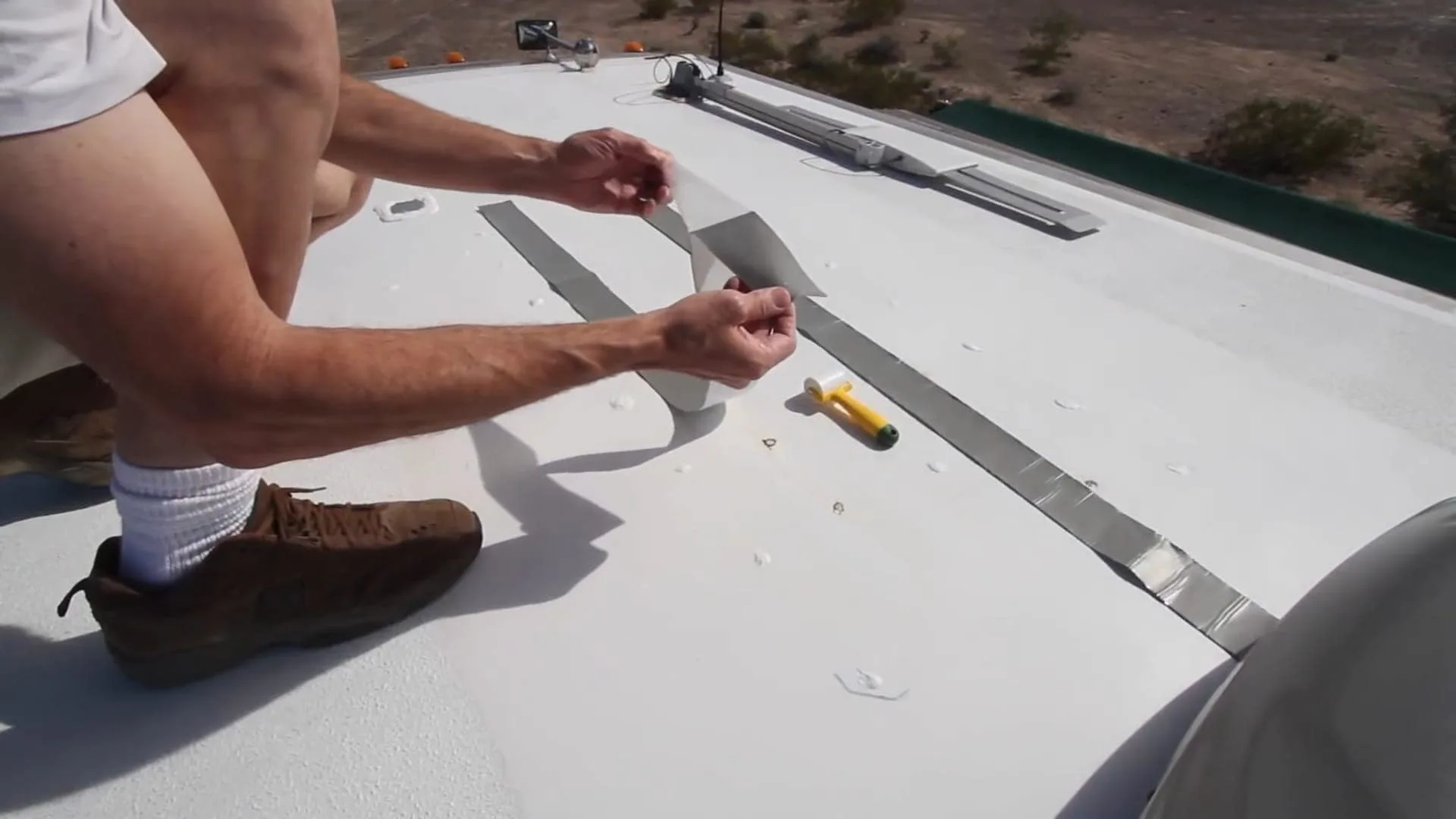
It’s crucial to monitor the condition of your roof regularly and maintain it well. Products like Eternabond tape and Dicor are great solutions for minor roof repairs. Preventing water penetration is Job 1!
You can walk on your EPDM roof when necessary, but only in soft-soled shoes… and being extremely careful if it’s wet, since it will be slippery, as mentioned above.
If your EPDM roof tears, specialized sealing tapes like Eternabond are usually the best choice to repair it. There are also RV roof patch kits available that may require an additional sealant. You should also keep an eye on any joints in your roof since a failed seal is the primary cause of rubber roof leaks.
TPO RV Roof
Thermal polyolefin (TPO for short) is another type of rubber membrane that has been a popular RV roofing material since the 1990s. It’s also among the most common types used on RVs, along with EPDM (although TPO is probably the first choice for manufacturers these days).
Pros
These durable roofs are resistant to mold, do not accumulate dirt, and are more difficult to damage by impact and punctures than EPDM. TPO roofs are also designed with UV protection to prevent deterioration of the material from exposure to the sun.
TPO is less slippery than EPDM due to an “orange peel” texture, making it safer to do any work on your RV’s roof when it’s wet. It’s also less prone to causing the white/black streaks down the side of your RV, since it doesn’t “shed” the same way that EPDM does.
Cons
A TPO roof won’t last quite as long as EPDM due to the breakdown of its chemical makeup from exposure to the elements, though it should still last 15-20 years with proper care and maintenance.
While less susceptible to punctures, TPO roofs may show divots from anything that impacts the roof (hail, branches, etc), with severe enough divots potentially leaving permanent damage in the material’s surface.
How to Care for a TPO RV Roof
Maintenance and repair of a TPO roof is identical to that of EPDM (see above) and involves regular cleanings to keep it in tip-top shape. You’re also able to walk on these roofs if necessary, but light traffic in soft-soled shoes is best, to avoid causing any unnecessary damage.
Fiberglass RV Roof
Fiberglass RV roofs are hardshell and generally installed in large panels or sheets overlaid on a wooden structural layer. Fiberglass is widely used in RVs, boats, and homes for its durability, functionality, and look.
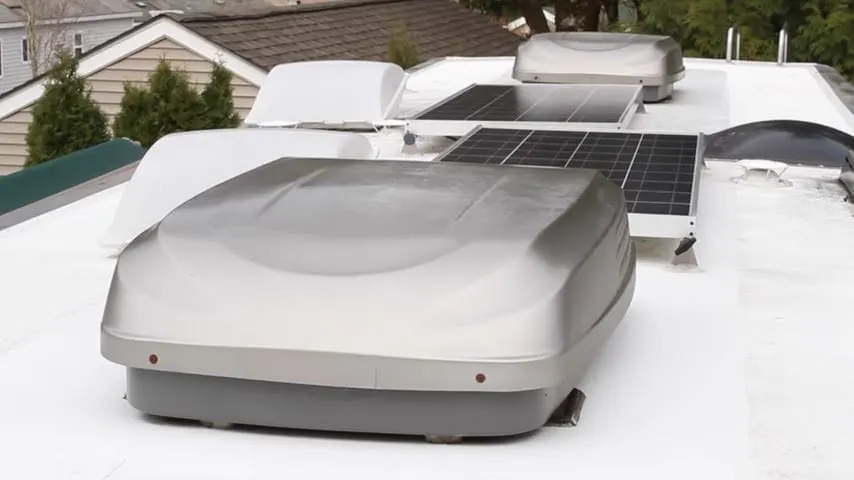
Understanding what your RV roof is made of and how best to maintain it is critical from day one of RV ownership.
Pros
Fiberglass is among the most sturdy and durable materials for an RV roof. It’s resistant to cracks, damage, rust, and rot, eliminating many of the most common issues you’ll encounter with other materials.
Additionally, fiberglass is a (relatively) lightweight material (although it is heavier than EPDM or TPO), and is customized in various shapes and colors for your specific RV. Fiberglass also requires the least maintenance of all RV roof styles.
Cons
Despite its sturdiness, fiberglass isn’t without its flaws. Fiberglass is one of the more expensive roofing materials to install initially (adding to the purchase cost of your RV). Additionally, if you encounter roof damage, repairs or replacements can be both expensive and time-consuming. Again, it’s also heavier than EPDM or TPO, so often not the most common choice for smaller RVs where total weight is a bigger factor.
How to Care for a Fiberglass RV Roof
Cleaning fiberglass roofs is pretty straightforward, as you can use the same mild automotive wash you’d use to clean the rest of your RV. They’re so durable that even using a pressure washer on them won’t damage the surface. Of course be careful about directing pressurized water into vents, antennas, or other areas that might allow water penetration.
You can walk on fiberglass roofs without damaging them. Just be careful when you’re cleaning up there, as they can be very slippery when wet, although some roofs have a roughened walk area to minimize slipperiness.
Even though they’re quite durable, it’s not a bad idea to treat your fiberglass roof annually with a dedicated fiberglass protectant or high-quality automotive wax to prevent oxidation damage.
You can accomplish some repairs using the same tapes and patch kits you would use on EPDM and TPO roofs. However, repairing more significant damage can make matters worse if you’re not very handy, and might best be left to a professional.
Aluminum RV Roof
Aluminum was once a trendy material for RV roofs. These days it’s less common, but some iconic retro-style trailers like the Airstream and a few other models still have it.
Pros
Aluminum is a durable and long-lasting roofing material that can stand up to severe weather, tree limbs, and other hazards. Its appearance is also pretty beautiful, providing a classy, elegant look.
Cons
Like fiberglass, aluminum is a heavier roof type, adding extra weight to your rig. It can also get extremely hot in the sun, soaking in heat that transfers into your RV.
Another downside is that in the event of damage, even something as small as a dent, aluminum is similar to the steel body panels of a typical passenger car. That means that a professional will likely be needed to repair any body damage.
How to Care for an Aluminum RV Roof
Like fiberglass roofs, you can clean aluminum with the same soap or wash product that you use on the rest of your RV or trailer, as long as it’s safe for clear coat finishes. You shouldn’t walk on an aluminum roof unless it has a reinforced structure so that you can put weight on it, since the aluminum panels used are thin, and walking on them could cause damage and be unsafe for you.
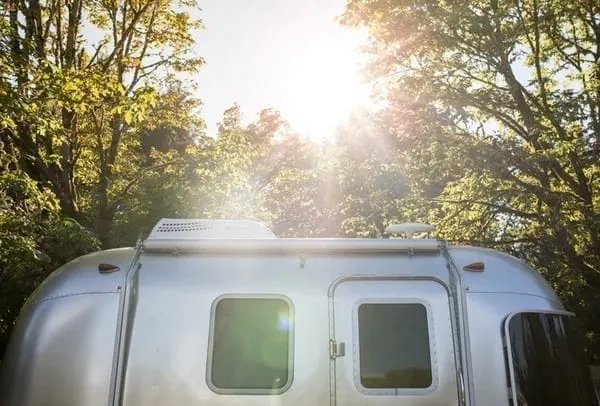
Aluminum RV roofs require special care just as all RV roofs do. Know your RV roof and best maintenance practices for it.
As with the other roof materials, you must also be mindful of sealing any exterior joints and rivets. You can repair damage to your aluminum RV roof using either special patches designed to adhere to metal or replacing the damaged panel altogether. Again, working with aluminum will likely require the services of a professional.
Keeping Things Sealed Properly
Again, Job 1 with an RV roof is preventing water on the outside from making its way inside.
Regardless of the material used on your RV’s roof, you need to be sure to regularly inspect it for any signs that water could penetrate. Joints, seams, and roof penetrations (roof vents, plumbing vents, skylights, antennas, etc) are all places where sealants can fail, resulting in problems.
When water gets through the seals and under your roof membrane, it can do significant damage to the underlying structure… often finding its way to places far from where it entered. The thing that makes leaks so damaging is that they’re insidious. You often have no idea that it’s going on until years of slow leaking are discovered to have caused major damage. By the time you become aware of the leak, the cost of repairs can be substantial.
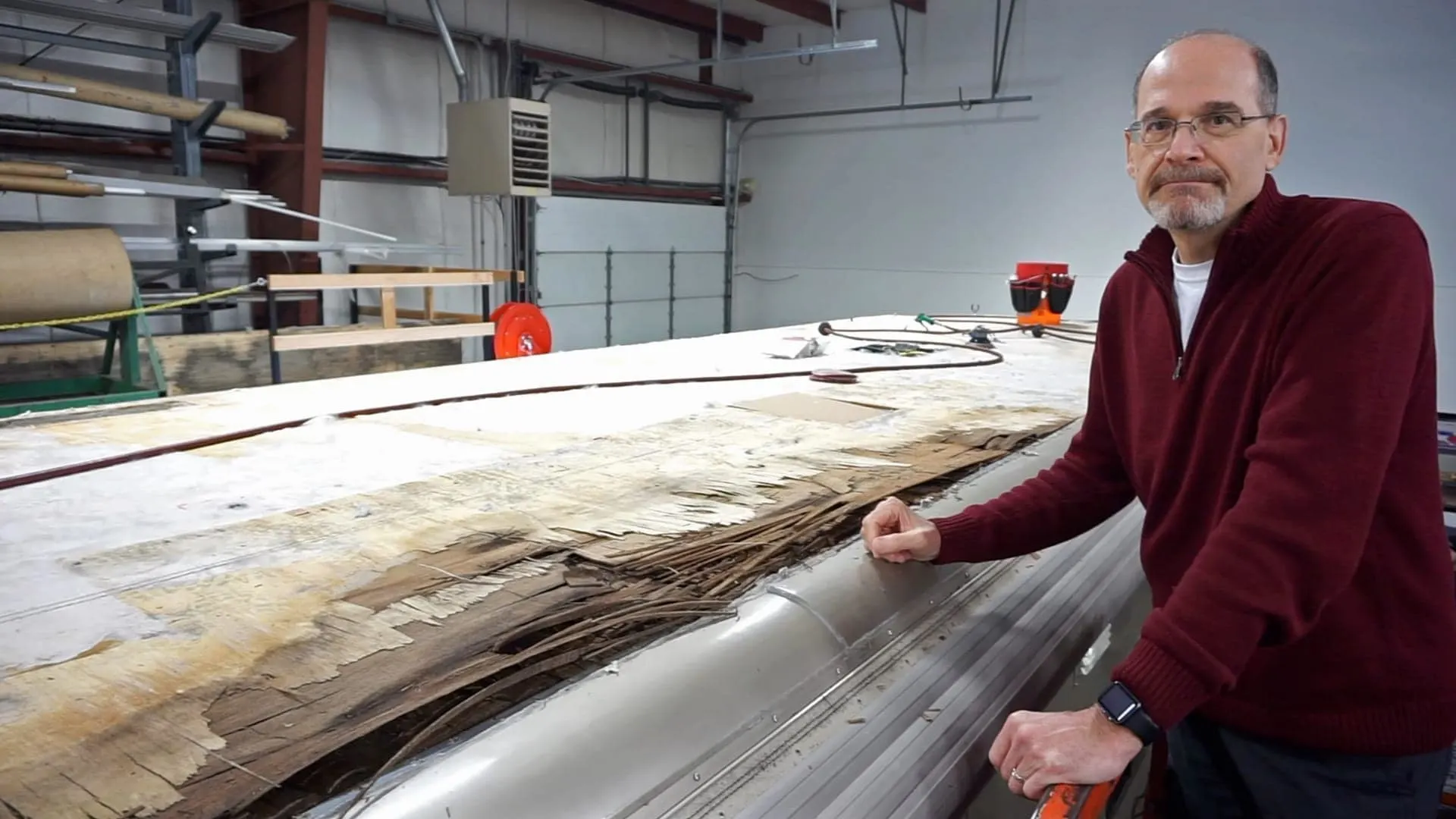
Maintaining your RV roof seals is important to prevent a leak… and serious damage. Watch the video to learn more.
At least once a year, you should inspect every potential opening, re-sealing where necessary to keep the water out. Most often, you’ll see Dicor Self-Leveling Lap Sealant used around these locations. Be sure to clean and inspect them all to keep things watertight.
But if things have gotten out of hand, or if you had an unfortunate meeting with a low-hanging tree branch, check out our post on How To Repair Holes in an RV Roof.
Wrapping up…
As you can see, manufacturers have several different options when it comes to RV roofing materials, allowing them to tailor their choice to the specific application. No matter which material they chose, it’s essential to keep up with the necessary maintenance, or you’ll risk significant problems. But with good maintenance, you can look forward to many trouble-free years with your RV roof.
Geek Out with Us Every Week
Join our newsletter to learn about all things RV-related. Every week we offer free tips, tricks, product reviews, and more to our online community of RVers. Whether this is your first time on the road or you’re a seasoned expert, we’d love for you to geek out with us!

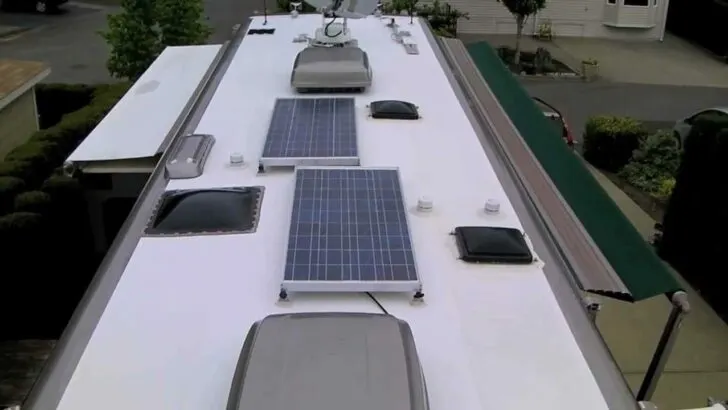
Rick
Tuesday 19th of September 2023
Hi ,
What about PVC roofs? Pros and cons.
thanks
TheRVgeeks
Monday 25th of September 2023
While it's been around in the construction industry for quite some time, PVC is a relative newcomer to the RV industry. It offers a lot of the same benefits of strength, durability, and weather resistance that the other "rubber roof" products do. We actually have the topic on our "To Do" list... so keep your eyes peeled! 😉
Farhad
Thursday 27th of July 2023
very good article. do you have any article about heat and sound insulation ?
TheRVgeeks
Friday 28th of July 2023
Hi Farhad. No... we don't have a specific article on those topics. We've covered using Reflectix style insulation to help insulate your windows when it gets very hot out (https://www.thervgeeks.com/how-to-stay-cool-in-an-rv-without-air-conditioning/#cover-windows-skylights-during-the-day), but haven't covered it on its own.
"Heat and sound insulation" is a pretty broad topic... was there something specific you were looking for?
Rick kramer
Sunday 14th of May 2023
i have an 2003 Montana 5th wheel with what I believe is an EPDM roof The white coating over the rubber membrane is worn off in some areas. Can I buy a product to resist this? Our local Home Depot has a couple of products made by Henry that’s are UV reflective coatings. Is that what I’m dealing with.?
TheRVgeeks
Tuesday 16th of May 2023
Sorry to hear about that, Rick. EPDM roofs do, indeed, have an outer white layer that's designed to improve their UV resistance and reflectivity (to help keep the RV cool). Sounds like your roof is having that layer separate from the base. You could try using rubber roof protectant to keep things moisturized and protected, which may help slow/stop the spread of the problem. If that doesn't work, we'd suggest you'd be better off using a product designed for use on RV roofs to re-coat it. We did an article about it: 5 Best RV Roof Coating Products
mary
Friday 17th of March 2023
my roof is called a "vinly/rubber composite roof membrane". Which roof is that??
TheRVgeeks
Sunday 19th of March 2023
Not sure from that description, Mary. It would help if you include the year, make and model of your RV.
James Brawdy
Friday 24th of February 2023
What type of sealant should I use on the seam of the roof and the front cap? Also, what would I need the clean the surface? The previous owner used silicone, so will I need to do something to be sure all that is removed? 2005 Winnebago Journey
Thank you
TheRVgeeks
Friday 24th of February 2023
Hi James. That's a good question... and one you should probably call Winnebago to confirm. They tend to use different sealants than many other RV manufacturers do... and a silicone-based sealant MAY be what they call for in that location.
If you're removing and replacing the existing silicone-based sealant, first physically get as much of it off as you can (without scratching paint, of course). Then you can use mineral spirits or denatured alcohol on a rag to rub away the residue that silicone leaves behind. It may take a couple of passes to get it all off and to be sure the surface is clean before applying the new sealant.
On our Newmar, our end caps are sealed to the roof using a bead of Dicor... and then there's a strip of Eternabond tape (4" wide) on top of that, equally overlapping the front cap and the roof (fiberglass).
Hope this helps!